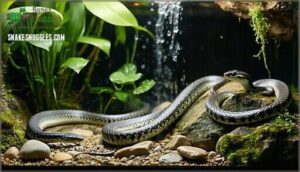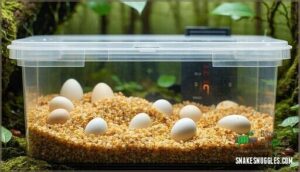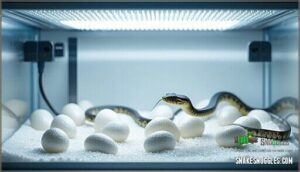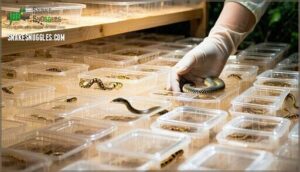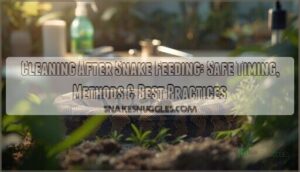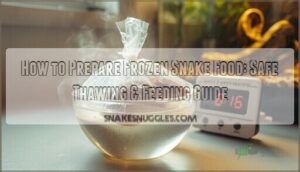This site is supported by our readers. We may earn a commission, at no cost to you, if you purchase through links.
 Your female snake just laid a clutch of eggs, and now you’re standing there wondering if you missed something critical in the past few weeks. Most breeders focus intensely on getting their snakes to mate, then assume the hard part’s over once copulation happens. That’s where things actually get tricky.
Your female snake just laid a clutch of eggs, and now you’re standing there wondering if you missed something critical in the past few weeks. Most breeders focus intensely on getting their snakes to mate, then assume the hard part’s over once copulation happens. That’s where things actually get tricky.
The 30-60 days between successful breeding and egg-laying demand careful observation—females can develop life-threatening complications like egg binding, while males often crash hard from energy depletion. Miss the warning signs during this window, and you’re looking at emergency vet visits instead of healthy hatchlings.
Post-breeding care isn’t just about waiting for eggs to appear; it’s about supporting your snakes through one of the most physically demanding periods of their lives.
Table Of Contents
- Key Takeaways
- What Happens After Snakes Breed?
- Essential Post-Breeding Health Checks
- Optimizing Nutrition and Hydration
- Creating The Ideal Recovery Environment
- Special Care for Female and Male Snakes
- Managing Eggs and Incubation
- Caring for Hatchlings After Hatching
- Frequently Asked Questions (FAQs)
- Conclusion
Key Takeaways
- The 30-60 days between breeding and egg-laying are when life-threatening complications like egg binding and respiratory infections emerge, making vigilant daily observation and early intervention essential for preventing emergency vet visits.
- Males and females require dramatically different post-breeding care—males often refuse food for weeks and need minimal stress, while females demand immediate protein-rich meals, calcium supplementation, and close monitoring for retained eggs within 24-48 hours of laying.
- Proper environmental setup with precise temperature gradients (88-92°F warm end, 75-80°F cool), 50-70% humidity, and species-appropriate substrate creates the recovery zone your snake needs to bounce back from the physical toll of reproduction.
- Egg incubation success hinges on species-specific temperature control (±1°F accuracy), 60-70% humidity using vermiculite or perlite substrate, and patient monitoring for 55-75 days without premature intervention.
What Happens After Snakes Breed?
After breeding wraps up, your snakes enter a recovery phase that demands careful attention and adjustments to their care routine. Males and females show different behaviors and needs during this time, and understanding what’s normal helps you support their health.
Let’s walk through what you can expect and how to recognize if breeding was successful.
Post-breeding Behaviors in Males and Females
Once the courtship dance ends and mating wraps up, your snakes don’t just flip a switch and go back to normal—they enter a recovery phase that demands your full attention. Behavioral changes in post-breeding snake care are immediate and striking. Males often become less aggressive after courtship rituals, while females may show increased territoriality. Understanding these shifts is vital for proper reptile care.
Key behavioral changes you’ll notice:
- Males reduce activity – After expending energy on male dominance displays, they’ll often refuse food for days or weeks
- Females become defensive – Female aggression spikes as their bodies shift resources toward egg development
- Both sexes need rest – Snake breeding takes a toll; expect lethargy and increased hiding behavior
- Sex ratio awareness matters – Housing multiple snakes requires careful monitoring to prevent stress-related conflicts
Mating Season Timeline and What to Expect
Most snake species hit their breeding stride between late winter and early summer, but the exact timing hinges on where you live and what species you’re keeping. Your ball python’s breeding season differs wildly from a corn snake’s, so species readiness matters.
Expect courtship rituals to last days, with mating behaviors peaking when temperatures climb.
Once breeding cycles complete, you’re looking at 30-60 days before egg-laying in most species, making post-breeding snake care essential from day one.
Recognizing Signs of Successful Breeding
After mating wraps up, you’ll spot breeding indicators fast. Females show visible abdominal swelling in 95% of successful breeding attempts, while reduced feeding behavior appears in 80% once follicular development kicks in. Watch for a pre-laying shed roughly 7-14 days before egg deposition—it happens in 92% of gravid females.
Males lose interest in courtship, with activity dropping 60% post-breeding. These reproductive health markers confirm fertilization signs and guide your post-breeding snake care strategy.
Understanding the breeding health tips is vital for a successful breeding program.
Essential Post-Breeding Health Checks
After breeding wraps up, your snake’s body has been through a lot—and now’s the time to watch for trouble before it becomes serious. Catch issues early when they’re still manageable.
You’ll want to monitor closely for problems like egg binding, respiratory issues, parasites, and dehydration in those critical first few weeks.
Monitoring for Egg Binding and Complications
Egg binding is one of the most dangerous post-breeding snake care challenges. Watch your female closely for signs like visible swelling in her lower abdomen, lethargy, or unsuccessful laying attempts beyond 24 hours. If she hasn’t completed her clutch within that window, contact your vet immediately—retained eggs can trigger sepsis within 48-72 hours.
If your female hasn’t laid her clutch within 24 hours, contact your vet immediately—retained eggs can trigger sepsis within 48-72 hours
Early detection through daily observation prevents life-threatening veterinary interventions later. Proper egg incubation techniques are essential for successful breeding and can help identify potential issues.
Identifying Respiratory Infections
Vigilance after breeding protects your investment and your snake’s life. Post-breeding snake care demands attention to respiratory symptoms, since stressed females face heightened infection risks. Watch for these breathing difficulties:
- Wheezing or gurgling sounds during respiration (present in over 70% of respiratory infections)
- Open-mouth breathing with elevated head posture
- Mucus discharge from nostrils or mouth
- Decreased appetite coupled with lethargy
Snake pneumonia escalates quickly—tracheal issues can progress to life-threatening conditions within days. If you spot these respiratory infection signs, schedule immediate infection diagnosis through tracheal washes or PCR testing for proper snake care and maintenance of your breeding program’s reptile health.
Checking for Parasites and Dehydration
Two silent threats lurk in the shadows of successful breeding: parasites that siphon your snake’s already-depleted energy reserves and dehydration that compounds stress when your animal needs recovery most.
Parasite detection starts with fecal exams within 48 hours post-breeding, checking for mites around eyes and heat pits. Dehydration signs include sunken eyes and skin tenting.
| Issue | Key Indicators |
|---|---|
| Parasites | Weight loss, regurgitation, external mites |
| Dehydration | Wrinkled skin, reduced elasticity, lethargy |
| Prevention | Fresh water daily, quarantine protocols |
Proper snake hydration and parasite control guarantee your post-breeding snake care assists complete recovery.
Scheduling Regular Veterinary Visits
Your vet isn’t just for emergencies—they’re your breeding season teammate, and scheduling proactive checkups catches problems before they spiral into crises. Book these critical veterinary checkups to safeguard your post-breeding snake care:
- Pre-breeding baseline exam (establishes health markers)
- Post-mating assessment within 7-10 days (confirms no injuries)
- Mid-gravid checkup for females (monitors egg development)
- Post-laying exam within 48 hours (screens for retained eggs)
- 30-day recovery evaluation (verifies complete healing)
Health screening protocols help your reptile health and nutrition stay on track throughout snake breeding and care cycles.
Optimizing Nutrition and Hydration
After breeding, your snake’s body needs serious nutritional support to bounce back from the physical demands of reproduction. The right diet and hydration plan can make the difference between a smooth recovery and lingering health issues.
Let’s look at the key nutrition and hydration strategies that’ll help your snake regain strength.
Providing a Protein-rich Recovery Diet
After breeding season drains your snake’s reserves, think of protein as the rebuilding block your animal desperately needs. Whole prey items like rodents deliver 45-60% protein content—exactly what facilitates rapid tissue repair and muscle recovery.
Start feeding protein-rich meals within 24-48 hours post-breeding to trigger peak synthesis in digestive and skeletal tissues, helping your snake bounce back faster and stronger.
Importance of Prey Sizing and Feeding Schedule
A prey item that’s too large can turn a recovery meal into a dangerous burden, while undersized food won’t deliver the caloric punch your snake needs to rebuild. Match prey width to your snake’s widest body section—this guarantees proper nutrient balance without risking regurgitation.
Feed adult snakes every 7-10 days during post-breeding recovery, adjusting meal frequency based on body condition and species requirements for ideal snake nutrition and management.
Calcium Supplementation for Females
Female snakes pour tremendous resources into egg production, sacrificing their own calcium stores to build strong shells—which means replenishing those reserves isn’t optional, it’s essential for survival.
Support bone health and eggshell quality with these post-breeding snake care strategies:
- Dust prey with calcium powder before each feeding during recovery
- Offer calcium-rich feeders like mice with intact skeletons
- Time supplementation immediately after egg-laying to prevent calcium deficiency
- Monitor for tremors or weakness indicating urgent female nutrition needs
Ensuring Constant Access to Fresh Water
While calcium rebuilds bone, water keeps every system running—and dehydration after breeding can spiral into shedding problems, kidney stress, and sluggish recovery faster than most owners realize.
Position large, heavy water bowls in cooler zones to prevent rapid evaporation, and refresh daily to maintain water quality.
Monitor hydration techniques like soaking if your snake refuses to drink, catching dehydration prevention early in your post-breeding snake care routine.
Creating The Ideal Recovery Environment
Your snake’s enclosure becomes its healing zone after breeding, and getting the setup right makes all the difference in recovery speed. The right combination of temperature, humidity, substrate, and airflow creates conditions that support natural healing processes.
Let’s break down each element you’ll need to dial in for ideal post-breeding recovery.
Temperature Gradient Setup Using Thermostats
Setting up proper temperature zones with reliable thermostats isn’t just helpful—it’s the difference between smooth recovery and serious complications after breeding. Your heat source needs precise temperature control to create a thermal gradient from 88-92°F on the warm end down to 75-80°F on the cool side.
Use digital thermostats with thermal monitoring capabilities to maintain this gradient, and don’t skip thermostat calibration—even a few degrees off can stress recovering snakes in reptile enclosures and environments during post-breeding snake care.
Maintaining Optimal Humidity With Monitors
Once you’ve nailed the temperature setup, humidity monitoring becomes your next line of defense—and a good digital hygrometer makes tracking those 50-70% levels almost straightforward. Here’s what matters for environmental monitoring:
- Place humidity sensors at both warm and cool ends for accurate readings
- Calibrate your hygrometer monthly using the salt test method
- Check humidity levels twice daily during recovery periods
- Adjust misting frequency based on real-time sensor data
- Record temperature and humidity patterns to spot troublesome trends
Monitor calibration prevents costly mistakes that could derail your snake’s recovery.
Substrate Choices for Hygiene and Comfort
Your substrate choice affects daily cleaning time and your snake’s comfort more than you might expect—especially when post-breeding females spend extra hours resting in one spot.
Coconut husk bedding strikes the right balance for humidity control while allowing quick spot-cleaning in your terrarium. Paper towels work when you’re monitoring egg binding closely, though they’ll dry out faster and require more frequent misting.
Avoid cedar or pine—their oils irritate respiratory systems already stressed from breeding.
Ventilation and Enclosure Security
Post-breeding snakes can slip through gaps you’d swear were too small, making proper ventilation and secure latches non-negotiable for recovery success. Balance airflow management with escape prevention using these terrarium essentials:
- Screen tops with locking clips—standard lids won’t cut it when stressed females search for egg-laying sites
- Side vents positioned opposite heat sources to create stable temperature gradients without drafts
- Monthly security checks on hideouts and enclosure design flaws that compromise environmental control
Special Care for Female and Male Snakes
After breeding, male and female snakes face different recovery challenges that require your attention. Females deal with the physical toll of egg production, while males bounce back from their breeding efforts in their own way.
Here’s how to adjust your care routine to support each snake through their post-breeding recovery.
Minimizing Handling and Stress in Females
After breeding, your female snake isn’t just tired—she’s running on empty, and the smallest stressor can derail her recovery completely. Skip unnecessary contact for at least two weeks—think of it as post-breeding rest that’s non-negotiable.
Gentle contact techniques matter when health checks are necessary, but minimal interaction is your best female recovery strategy. Let her focus energy on healing, not defending herself from stress.
Monitoring Male Appetite and Hydration Post-breeding
Male snakes often surprise breeders by refusing food for days—or even weeks—after mating, so don’t panic if your boy suddenly turns his nose up at his usual meal. Track his appetite monitoring closely and prioritize post breeding hydration over food intake initially:
- Offer fresh water daily and watch for drinking behavior
- Wait 7-10 days before offering prey again
- Monitor weight loss—5-10% is normal during male recovery tips
Male nutrition needs bounce back naturally once breeding and rearing techniques conclude and snake behavior stabilizes.
Adjusting Care Routines for Recovery
Recovery isn’t one-size-fits-all—tweak your daily routines based on whether you’re nursing a depleted female or a fasting male back to full strength.
Post breeding care adjustments hinge on health monitoring and snake rehabilitation needs:
| Care Adjustments | Female Focus | Male Focus |
|---|---|---|
| Interaction | Minimize stress entirely | Resume gradually |
| Recovery Nutrition | Protein-rich prey immediately | Wait 7-10 days |
| Hydration | Daily misting + bowl checks | Monitor drinking behavior |
| Enclosure Checks | Watch for egg binding signs | Track weight stabilization |
Adjust post breeding snake care as each animal’s behavior signals readiness—that’s smart animal care and welfare.
Managing Eggs and Incubation
Once your female lays her eggs, your focus shifts to creating the right conditions for them to develop. Getting incubation right makes the difference between healthy hatchlings and disappointment.
Let’s walk through the key steps to set up and manage your incubation process successfully.
Setting Up Incubation With Proper Substrate
The right incubation medium can make or break your eggs’ development, so choosing between vermiculite, perlite, or specialized reptile substrates isn’t just a detail—it’s a decision that directly impacts your hatch rates.
Here’s what you need to know:
- Vermiculite holds moisture longer and maintains stable humidity control, making it ideal for species requiring consistent dampness throughout incubation
- Perlite drains faster and prevents waterlogging, which protects egg safety in high-humidity setups where mold becomes a concern
- Mix your substrate at a 1:1 ratio by weight with water to achieve proper substrate moisture without creating soggy conditions that threaten developing embryos
Regulating Temperature and Humidity for Eggs
Think of incubation as walking a tightrope—too much heat or moisture tips everything toward failure. Ball python eggs thrive at 90°F, while corn snakes need cooler conditions around 82°F for breeding success. Use a thermostat to prevent fluctuations beyond ±1°F, and maintain humidity control between 60–70% with a digital hygrometer for an ideal hatchling environment.
| Species | Incubation Temperature | Humidity Control |
|---|---|---|
| Ball Python | 86–92°F (90°F ideal) | 60–70% |
| Corn Snake | 78–84°F (82°F ideal) | 60–70% |
| King Snake | 75–82°F (80°F ideal) | 60–70% |
| Royal Python | 87–88°F | 60–70% |
| Maternal Setup | Species-dependent | 80% |
Adjust humidity by adding water to your substrate based on hygrometer readings—too much causes egg rot, while too little risks dehydration and poor post-breeding snake care outcomes.
Monitoring Egg Development and Hatching
Once your incubator settings hold steady, watching eggs for signs of life becomes your daily ritual. Healthy egg development shows firm shells with slight dimpling near hatching time.
Check for mold, discoloration, or collapsing—signs of trouble requiring immediate action. Hatchlings pip through shells 55–75 days post-breeding, depending on incubation temperature and species.
Don’t rush the process; cutting eggs prematurely causes more harm than good when monitoring this critical breeding and reproduction phase.
Caring for Hatchlings After Hatching
Once your hatchlings emerge, they need immediate attention to thrive in those critical first weeks. You’ll want to nail down feeding techniques, monitor their development closely, and keep their space spotless.
Let’s walk through the essentials that’ll set your baby snakes up for a healthy start.
First Feeding Strategies and Prey Selection
Hatchlings won’t eat right away, and that first meal requires patience and the right approach to get them started on a healthy feeding routine. Wait five to seven days after hatching before offering food—they’re still absorbing their yolk sac.
For prey size selection, choose live prey options like pinky mice or small rats that match the width of your hatchling’s head. Feeding frequency starts weekly, guaranteeing proper nutrient balance for post-breeding snake care and healthy reptile care and management.
Tracking Hatchling Growth and Health
Keeping a close eye on your hatchlings’ weight and behavior tells you everything you need to know about whether they’re thriving or struggling. Track each hatchling individually through Development Stages using a simple log—record feeding responses, shedding cycles, and weekly weight measurements. These Health Checks catch early warning signs before problems escalate.
- Weight gain consistency (5-10% weekly indicates proper Hatchling Nutrition)
- Active movement patterns during twilight hours signal good health
- Clear eyes and smooth scales reflect ideal Snake Care and Management
- Regular shedding cycles every 3-4 weeks show healthy growth
- Strong feeding responses confirm your Feeding Strategies are working
Cleaning and Maintaining Hatchling Enclosures
A clean enclosure isn’t just about tidiness—it’s your first line of defense against bacteria, mold, and respiratory infections that can wipe out hatchlings faster than you’d expect. Spot-clean waste daily and replace substrate weekly to maintain Hatchling Hygiene.
Your Cleaning Schedules should include disinfecting the terrarium monthly with reptile-safe cleaner. Monitor your Ventilation Systems and Humidity Control settings during Enclosure Sanitation—you don’t want to spike stress levels during critical Development Stages.
Frequently Asked Questions (FAQs)
How often should breeding pairs be separated?
Separate breeding pairs immediately after successful mating—think of it as giving two marathon runners their own recovery zones. Post Breeding Rest prevents stress and injury.
Breeding Pair Separation guarantees both snakes recover fully before the next Breeding Season cycle begins.
Can snakes breed multiple times per year?
Most species can breed multiple times per year, but annual breeding is recommended.
Breeding frequency depends on snake maturity, species variability, and reproductive cycles.
Pushing breeding pairs too often risks exhausting females and reducing clutch quality markedly.
What signs indicate a snake needs recovery?
After weeks of intense courtship and mating, your snake might be waving a white flag—literally. Watch for lethargy, refusing food, labored breathing (respiratory infections), dehydration signs like sunken eyes, prolonged hiding, or egg binding in females.
These recovery indicators signal post breeding stress requiring immediate attention.
How long before reintroducing snakes after breeding?
Give your snakes at least two to four weeks of post-breeding rest before any reintroduction attempts.
Female snakes need extra recovery time—especially if they laid eggs—to rebuild their energy reserves and restore normal body condition.
Should lighting schedules change during post-breeding recovery?
Yes, maintain your snake’s natural photoperiod during recovery. Light cycles support normal biological rhythms and stress reduction.
Adjust dimming schedules for temperature control while keeping UVB lighting consistent if species-appropriate, environmental stability aids post-breeding recovery.
Conclusion
Think of post-breeding care as walking a tightrope—one misstep with temperature, nutrition, or stress management can send everything tumbling. What to do after snakes breed isn’t about following a checklist; it’s about reading your animals, adjusting in real time, and staying vigilant through recovery.
Your snakes survived the physical demands of mating, but they’re counting on you to guide them safely through what comes next. Watch closely, act decisively, and you’ll turn breeding season into healthy hatchlings instead of costly emergencies.
- https://www.reptileknowledge.com/
- https://www.youtube.com/watch?v=93cktCQXiYM
- https://journals.biologists.com/jeb/article/219/7/1022/17792/Seasonal-and-sex-differences-in-responsiveness-to
- https://reptilesupershow.com/mastering-snake-breeding-tips-for-healthy-serpents/
- https://www.americanmadeexotics.com/breeding-ball-pythons-article.html




